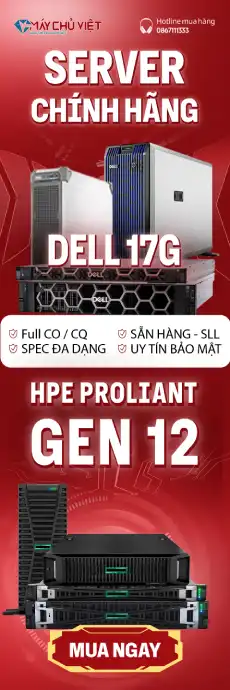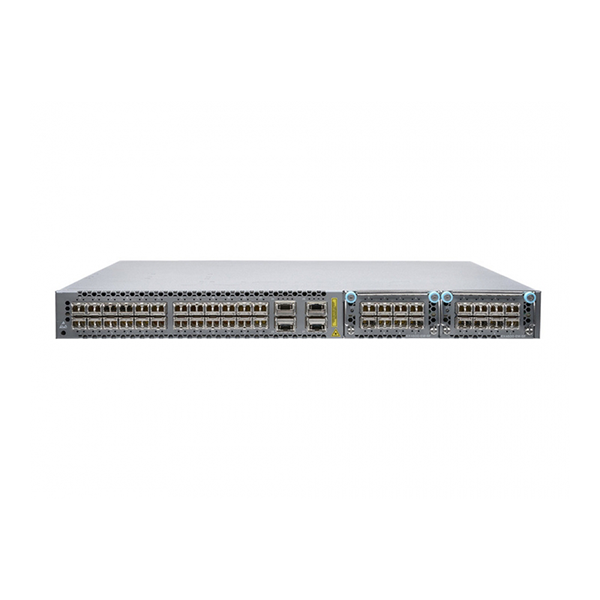Thông Số Kỹ Thuật EX4600-40F-AFO
| Hardware Specifications | |
| Interface Options | • 1GbE SFP: 24(40) (with 10GbE expansion modules) • 10GbE SFP+: 24(40/72) (with 10GbE expansion modules/ with fixed 40GbE ports using breakout cables) • 40GbE QSFP+: 4(12) (with expansion modules) – Each fixed QSFP+ port can be configured as a 4x10GbE interface – Each QSFP+ port can be configured as a 40 Gbps port – USB port – Console port – 2 management ports: 1 RJ-45 and 1 SFP – Supported transceiver and direct attach cable – SFP+ 10GbE optical modules – SFP+ DAC cables: 1/3/5 m direct-attached copper and 1/3/5/7/10 m active direct-attached copper – SFP GbE optical and copper module – QSFP+ to SFP+ 10GbE direct attach bre |
| Switching capacity | 1.44 Tbps/1.07 Bpps |
| Weight | 21.7 lb (9.84 kg) with PSUs and fans installed |
| Dimensions (HxWxD) | 1.72 x17.36 x 20.48 in (4.37 x 44.09 x 52.02 cm) |
| Switching mode | Cut-through and store-and-forward |
| Predicted mean time between failures (MTBF) | 150,000 hours |
| Predicted FIT rate | 4,987 |
| Rack Installation Kit | Versatile four post mounting options for 19-in server rack or datacom rack |
| Airflow | Front-to-back cooling |
| Power Supply | • Dual redundant (1+1) and hot-pluggable power supplies • 110-240 V single phase AC power • Redundant (N+1) and hot-pluggable fan modules for frontto-back and back-to-front airflow |
| Performance Scale | • MAC addresses per system: 288,000 • VLAN IDs: 4,091 • Number of LAGs: 128 • Number of ports per LAG: 32 • FCoE scale: – Number of FCoE VLANs/FC virtual fabrics • Firewall filters: 4,000 • IPv4 unicast routes: 128,000 prefixes; 208,000 host routes; 64** ECMP paths • IPv4 multicast routes: 104,000 • IPv6 multicast routes: 52,000 • IPv6 unicast routes: 64,000 prefixes • Address Resolution Protocol (ARP) entries: 48,000 • Jumbo frame: 9,216 bytes |
| Software Specifications | |
| Access Control Lists (ACLs) | • Port-based ACL (PACL): Ingress and egress • VLAN-based ACL (VACL): Ingress and egress • Router-based ACL (RACL): Ingress and egress • ACL entries (ACE) in hardware per system: – Ingress ACL: 1,536 – Egress ACL: 1,024 • ACL counter for denied packets • ACL counter for permitted packets • Ability to add/remove/change ACL entries in middle of list (ACL editing) • L2-L4 ACL • IPv6 ACL • Firewall filter on loopback interface • Firewall filter on management interface |
| Spanning Tree Protocol (STP) | • Multiple Spanning Tree Protocol (MSTP) instances: 64 • VLAN Spanning Tree Protocol (VSTP) instances: 253 |
| Traffic Mirroring | • Mirroring destination ports per switch: 4 • Maximum number of mirroring sessions: 4 • Mirroring destination VLANs per switch: 4 |
| Layer 2 Features | • STP—IEEE 802.1D (802.1D-2004) • Rapid Spanning Tree Protocol (RSTP) (IEEE 802.1w); MSTP (IEEE 802.1s) • Bridge protocol data unit (BPDU) protect • Loop protect • Root protect • RSTP and VSTP running concurrently • VLAN—IEEE 802.1Q VLAN trunking • Routed VLAN interface (RVI) • Port-based VLAN • MAC address filtering • GRE tunneling • QinQ** • VLAN translation • Static MAC address assignment for interface • Per VLAN MAC learning (limit) • MAC learning disable • Link Aggregation and Link Aggregation Control Protocol (LACP) (IEEE 802.3ad) • IEEE 802.1AB Link Layer Discovery Protocol (LLDP) • MAC notification • MAC address aging configuration • MAC address filtering • Persistent MAC (sticky MAC) |
| Link Aggregation | • Multichassis link aggregation (MC-LAG) – Layer 2, Layer 3, VRRP, STP • Redundant trunk group (RTG) • LAG load sharing algorithm—bridged or routed (unicast or multicast) traffic: – IP: SIP, Dynamic Internet Protocol (DIP), TCP/UDP source port, TCP/UDP destination port – Layer 2 and non-IP: MAC SA, MAC DA, Ethertype, VLAN ID, source port – FCoE packet: Source ID (SID), destination ID (DID), originator exchange ID (OXID), source port |
| Layer 3 Features (IPv4) | • Static routing • Routing policy • Routing protocols (RIP, OSPF, IS-IS, BGP, MBGP) • Virtual Router Redundancy Protocol (VRRP) • Bidirectional Forwarding Detection (BFD) protocol • Virtual router • Dynamic Host Configuration Protocol (DHCP) relay • Proxy Address Resolution Protocol (ARP) • Multicast Features • Internet Group Management Protocol (IGMP): v1, v2, v3 • IGMP snooping: v1, v2, v3 • IGMP filter • PIM-SM • Multicast Source Discovery Protocol (MSDP) • Security and Filters • Secure interface login and password • RADIUS • TACACS+ • Ingress and egress filters: Allow and deny, port filters, VLAN filters, and routed filters, including management port filters • Filter actions: Logging, system logging, reject, mirror to an interface, counters, assign forwarding class, permit, drop, police, mark • SSH v1, v2 • Static ARP support • Storm control, port error disable, and autorecovery • Control plane denial-of-service (DoS) protection • Dynamic ARP inspection (DAI) • Sticky MAC address • DHCP snooping • Filter based forwarding • IP directed broadcast traffic forwarding • IPv4 over GRE (encap and decap) |
| Layer 3 Features: IPv6 | • Static routing • Routing protocols (RIPng, OSPF v3, IS-IS v6, BGP v6) • Virtual Router Redundancy Protocol (VRRP v3) • IPv6 CoS (BA, MF classification and rewrite, scheduling based on TC) • IPv6 over MPLS LSPs (6PE) • IPv6 ping • IPv6 traceroute • Neighbor discovery protocol • Path MTU discovery • SNMP, NTP, DNS, RADIUS, TACACS+, AAA • Virtual router support for IPv6 unicast |
| Quality of Service (QoS) | • L2 and L3 QoS: Classification, rewrite, queuing • Rate limiting: – Ingress policing: 1 rate 2 color, 2 rate 3 color – Egress policing: Policer, policer mark down action – Egress shaping: Per queue, per port • 12 hardware queues per port (8 unicast and 4 multicast) • Strict priority queuing (LLQ), smoothed deficit weighted round-robin (SDWRR), weighted random early detection (WRED), weighted tail drop • 802.1p remarking • L2 classification criteria: Interface, MAC address, Ethertype, 802.1p, VLAN • Congestion avoidance capabilities: WRED • Trust IEEE 802.1p (ingress) • Remarking of bridged packets • Priority-based flow control (PFC)—IEEE 802.1Qbb • Enhanced Transmission Selection (ETS)—IEEE 802.1Qaz • Data Center Bridging Exchange Protocol (DCBX), DCBx FCoE, and iSCSI type, length, and value (TLVs) • Fibre Channel over Ethernet (FCoE) • FCoE transit switch (FIP snooping ACL installation) • Virtual fiber channel gateway • FCoE session path learning • FCoE session health monitoring • Graceful restart for FIP snooping • FC-BB-6 VN2VN snooping |
| Virtual Chassis | • 40GbE and 10GbE as Virtual Chassis port • Virtual Chassis Routing Engine (RE) election • Virtual Chassis pre-provisioning (plug and play) • Auto-LAG formation of Virtual Chassis ports • Mixed Virtual Chassis support between EX4300-EX4600 (in data center only) • FCoE transit across Virtual Chassis members • QoS on Virtual Chassis ports • Local designated forwarding • Graceful RE switchover (GRES) • Nonstop routing (NSR) • Nonstop bridging (NSB) • Monitor distributed aggregate interface • Control plane protection for virtual RE |
| High Availability | • ISSU (in standalone and MC-LAG configuration) • Bidirectional Forwarding Detection (BFD) • Uplink failure detection (UFD) • Graceful Routing Engine switchover (GRES) in Virtual Chassis configuration • Non-stop bridging (NSB) in Virtual Chassis configuration • Non-stop routing (NSR) in Virtual Chassis configuration • Non-stop software upgrade (NSSU) in Virtual Chassis configuration |
| MPLS | • VRF-Lite • 2-label stack • Static label-switched paths (LSPs) • RSVP-based signaling of LSPs • LDP-based signaling of LSPs • LDP tunneling (LDP over RSVP) • MPLS class of service (CoS) • MPLS access control list (ACL)/policers • MPLS LSR support • Push, swap, pop, IP lookup • IPv6 tunneling (6PE) (via IPv4 MPLS backbone) • MPLS Operation, Administration, and Maintenance (OAM)— • LSP ping • IPv4 L3VPN (RFC 2547, 4364) • Ethernet-over-MPLS (L2 circuit) • Layer 3 VPN (L3VPN) • Layer 2 VPN (L2VPN) • Link protection • MPLS fast reroute (FRR)- 1:1 Protection • Node-link protection |
| Traffic Mirroring | • Port-based • LAG port • VLAN-based • Filter-based • Mirror to local • Local/L2 remote analyzer (SPAN, RSPAN for IPv4 and IPv6 frames) • Mirror to remote destinations (L2 over VLAN) • Insight Technology (microburst monitoring and statistics reporting) |
| Safety and Compliance | |
| Safety Certifications | • CAN/CSA-C22.2 No. 60950-1 (2007) Information Technology Equipment—Safety • UL 60950-1 (2nd Ed.) Information Technology Equipment— Safety • EN 60950-1 (2005) Information Technology Equipment— Safety • IEC 60950-1 (2005) Information Technology Equipment— Safety (All country deviations): CB Scheme report. • EN 60825-1 +A1+A2 (1994) Safety of Laser Products—Part 1: Equipment Classification • GR-63-Core (2006) Network Equipment, Building Systems (NEBS) Physical Protection • GR-1089-Core (2006) EMC and Electrical Safety for Network Telecommunications Equipment • SR-3580 (1995) NEBS Criteria Levels (Level 3) |
| Electromagnetic Compatibility Certifications | • FCC 47CFR, Part 15 Class A (2009) USA Radiated Emissions • EN 55022 Class A (2006)+ A1 2007 European Radiated Emissions • VCCI Class A (2007) Japanese Radiated Emissions • BSMI CNS 13438 and NCC C6357 Taiwan Radiated Emissions • AS/NZS CISPR22:2009 |
| Environmental | • Reduction of Hazardous Substances (ROHS) 5 • Telco • Common Language Equipment Identifier (CLEI) code |
| Environmental Ranges | • Operating temperature: 32° to 104° F (0° to 40° C) • Storage temperature: -40° to 158° F (-40° to 70° C) • Operating altitude: up to 2,000 • Relative humidity operating: 5% to 90% (noncondensing) • Relative humidity nonoperating: 0% to 95% (noncondensing) |
| Telco | Common Language Equipment Identifier (CLEI) code |
Chi tiết specs xem tại đây




Đánh giá